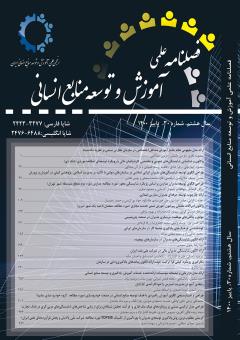ارائه مدل مفهومی نظام جامع آموزش مشاغل اختصاصی سازمان نظارتی مبتنی بر نظریه دادهبنیاد
محورهای موضوعی : مدل های بلوغ آموزش و توسعه در سازمان و نحوه ارزیابی آنمعصومه باقری 1 * , فردین باتمانی 2 , فردین عبداللهی 3
1 - دانشجوی دکترا مدیریت آموزشی، واحدسنندج، دانشگاه آزاد اسلامی، سنندج، ایران
2 - استادیار گروه علوم تربیتی، واحد سنندج، دانشگاه آزاد اسلامی، سنندج، ایران
3 - استادیار گروه علوم تربیتی، واحد سنندج، دانشگاه آزاد اسلامی، سنندج، ایران
کلید واژه: مدلسازیمدل مفهومی نظام جامع آموزش نظریه دادهبنیاد,
چکیده مقاله :
پژوهش حاضر باهدف ارائه مدل مفهومی نظام جامع آموزش برای مشاغل اختصاصی سازمان نظارتی انجام شد. ازنظر نوع پژوهش کیفی و روش پژوهش نیز سیستماتیک برخاسته از دادههای استراوس و کوربن بود. مشارکتکنندگان بالقوه پژوهش را کلیه کارشناسان، نخبگان و اساتید شاغل در مشاغل اختصاصی سازمان نظارتی تشکیل می دادند. برای نمونهگیری از نوع هدفمند نظری استفاده شد. حجم مشارکتکنندگان به تعداد 33 نفر است که با آنها مصاحبه نیمهساختاریافته انجام شده است و افرادی انتخاب شدند که بیشترین اطلاعات و داده را برای پاسخ به سؤالات فراهم نمودند و مصاحبهها تا رسیدن به نقطه اشباع و حداکثر اطلاعات ادامه یافت. جهت تجزیهوتحلیل اطلاعات از روش کدگذاری باز، محوری و گزینشی با استفاده از نرمافزار مکس کیودا استفاده شده است. نتایج پژوهش نشان داد: مدل مفهومی بهدستآمده دارای 673 مفهوم، 126 مؤلفه و 18 مقوله است و مقولات آن شامل: شرایط علَی ( شناسایی عوامل مؤثر در ضعف آموزش، بازنگری در وضعیت موجود، وضعیت کمی و عوامل کیفی آموزش، بازنگری در شناسنامه آموزشی مشاغل)، شرایط زمینهای (ضرورت آموزش، عوامل اقتصادی، اجتماعی و قانونی)، شرایط مداخلهگر (سیاستگذاری و بازنگری در شرح وظایف) راهبردها (نظارت و ارزشیابی، نیازسنجی واقعبینانه، بازنگری در محتوای آموزش و هدفگذاری) و پیامدها (تدوین نظام جامع آموزش، ایجاد انگیزه در کارکنان و برنامهریزی هدفمند) است.
The aim of this study was to provide a conceptual model of a comprehensive education system for the specific jobs of the regulatory organization. In terms of the type of qualitative research and research method, it was systematically derived from Strauss and Corben data. Potential research participants were all experts, elites and professors working in the specific jobs of the regulatory body. Theoretical purposive sampling was used. The number of participants was 33 people with whom a semi-structured interview was conducted and the individuals who provided the most information and data to answer the questions were selected and the interviews continued until reaching the saturation point and maximum information. Open, axial and selective coding methods, as well as MAXQDA software were used to analyze the information. The results showed: The obtained conceptual model has 673 concepts, 126 components and 18 categories and its categories include: causal conditions with categories: identification of effective factors in poor education, review of the current situation, quantitative status and qualitative factors of training, review In the job description, background conditions with categories: necessity of education, economic, social and legal factors, intervention conditions with categories: policy-making and review of job descriptions and categories of strategies, including: monitoring and evaluation, realistic needs assessment, review of training content and targeting, Implications are also with the categories: developing a comprehensive training system, motivating employees and purposeful planning.
1. Darville R. Comparative Study of Strategies, Policies and Constraints. Adult Education Quarterly. 2018;68(4):348-72.
2. vanderSteen M, Twist mV, Frissen P. Learning from experience. 2016;35(1):105-25.
3. Pacheco R, Franzese C. Executive programs for Brazilian mid-career public managers Pitfalls and challenges. Teaching Public Administration. 2017;35(1):38-49.
4. Knassmüller M. Culture matters – the training of senior civil servants in Austria, Germany, the Netherlands and Switzerland. Teaching Public Administration. 2015;34(9):120-49.
5. Lochan D. Service quality and the training of employees: The mediating role of organizational commitment Tourism Management. 2015;46(1):419-30.
6. Mashayekh F. New perspectives on educational planning. Tehran: Samat.; 2015.
7. Saadat E. Human resources management. Tehran: Samat; 2007.
8. Abtahi H. Training and improvement of human capital. Tehran: Paivand; 2004.
9. Alwani M. Public Management. Tehran: Ney; 2009.
10. Salas E, Wilson K, Priest M, Guthrie J. Design, Delivery, and Evaluation of Training system2006.
11. Mashayekh F. UNESCO Advisory Group Educational planning process. Tehran: School; 2008.
12. Kaufman R, Herman J. Strategic plan in the educational system. Tehran: Madrasa; 2006.
13. Hall A, Fagen R. General systems theory and human communication: Hayden Book company. Inc.; 1975.
14. Cortes F, Prezeworski A, Sprague J. Systems analysis for social scientists: New York: John Wiley & Sons; 1974.
15. Goldstein I, Ford J. Training in organization. rded, editor. New York: Mc Graw Hill 2004.
16. Kopp T, Kinkel S, Schäfer T, Kieslinger B, Brown A. Measuring the impact of learning at the workplace on organizational performance. International Journal of productivity and performance management, emerald geoup publishing. 2020;69(7):1455-74.
17. Demirchi M, Hosseini R, Oladian M. Designing a model for empowering Sepah Bank employees based on organizational learning. Journal of Human Resources Education and Development. 2019:1-25.
18. M B, Davoodi R, Kamali N. Entesar Foumani G. Identify the dimensions and components of human resource improvement in education in order to provide a conceptual model. Quarterly Journal of Human Resource Management Research. 2018:75-101.
19. Pallai K, Gregor A. Assessment of effectiveness of public integrity training workshops for civil servants – A case study. Teaching Public Administration. 2016;34(3):247-69.
20. Amouzad M, Ghahremani M, Khorasani A, Faraskhah M. Study of staff training and development system in Iranian organizations (study of the current situation). Quarterly Journal of Human Resources Education and Development. 2015;7(1):25-73.
21. Grossman R, Salas E. The transfer of training: What really matters. international Journal of training and development. 2011;15(2):103-20.
22. A B. Introduction to qualitative and mixed research methods. Tehran: Didar; 2015.
23.
Strauss N, Corbin J. Principles of Qualitative Research Methodology: Basic Theory of Procedures and Methods. Tehran: Institute of Humanities and Cultural Studies; 1990 2014.
24.
Azkia M, Jajarmi HI, Miandehi ZF. Applied research methods; Application of fundamental theory. Tehran: Kayhan Publishing Company; 2011.
25.
L G. Epidemiology Tehran: Arjmand; 2014.

